
Britain’s largest land mollusc, Helix pomatia, is often known as the ‘Roman’ Snail because they were initially introduced during the Roman period, although they have been re-introduced numerous times since then.
Locally frequent in chalky habitats across southeast England. In England, the Roman snail is a protected species. See more species information at NBN Atlas
© Aah-Yeah, Flickr
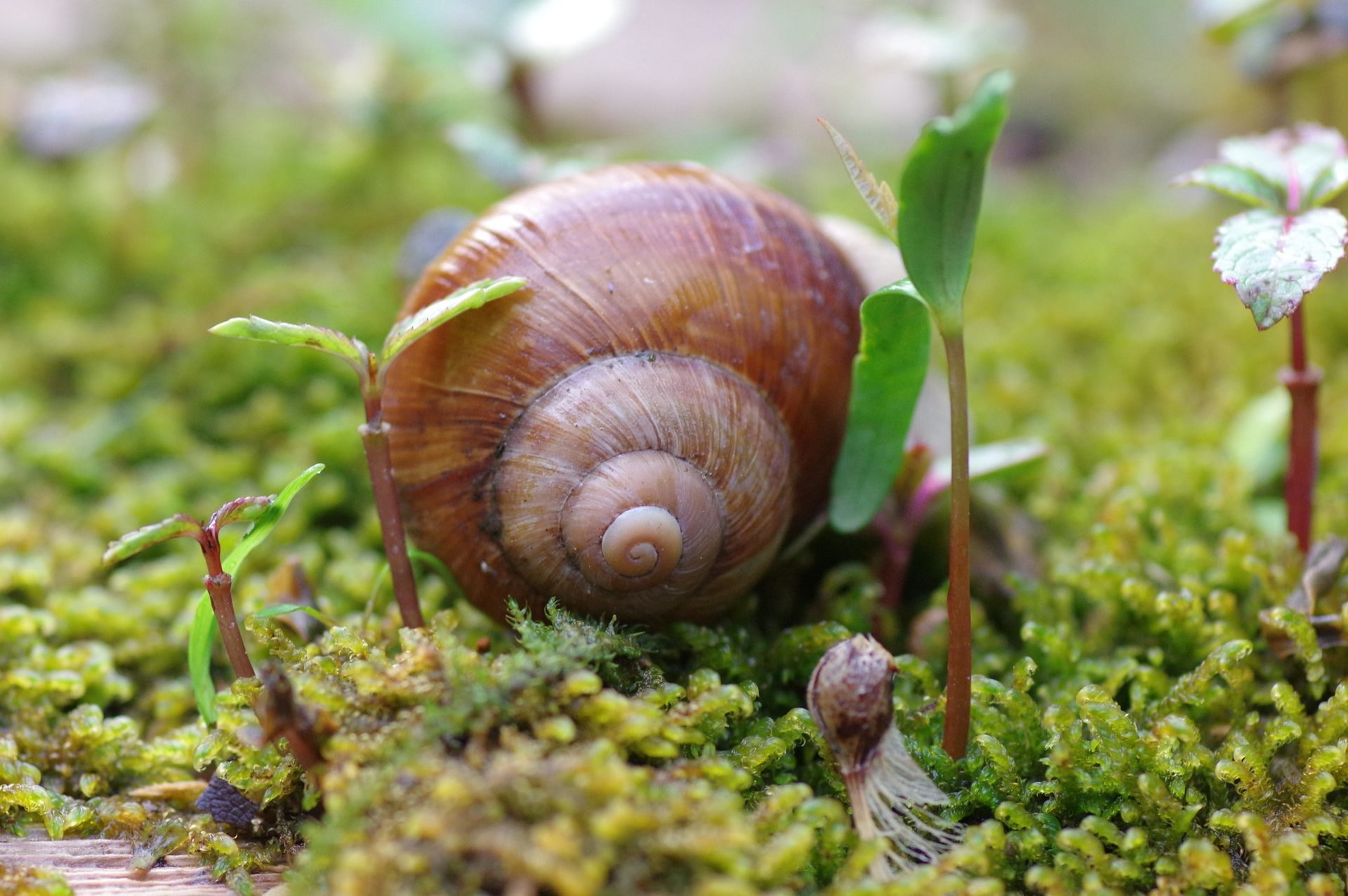
Roman snails have a large creamy brown shell (up to 5cm across) with a ridged texture, it may be striped but never has a zigzag pattern.
Roman snails are the only species that form a calcified white structure over the mouth of the shell to hibernate over the winter called an epiphragm.
© Aah-Yeah, Flickr
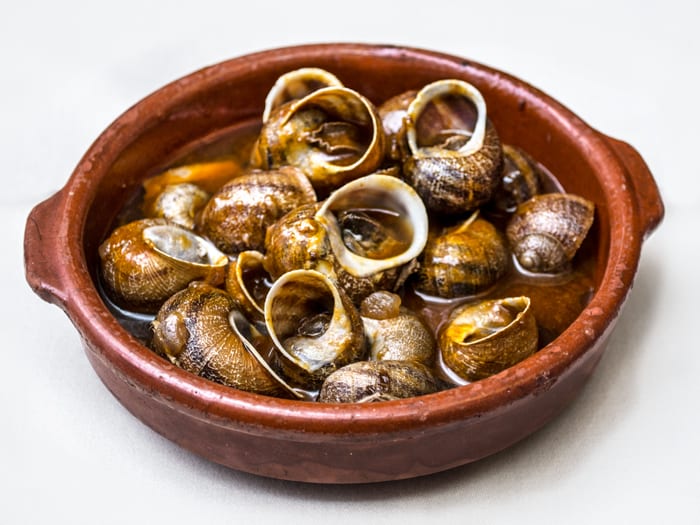
Roman snails were eaten by both Ancient Greeks and Romans. Nowadays, they are especially popular in French cuisine and when used in cooking are called escargot (the French word for snail).
However, they are difficult to cultivate and are rarely farmed commercially.
© Restaurante Granero, Flickr

They are herbivores with a diet that includes fruits, vegetables, leaves, flowers and tree sap.
It takes three to five years to reach maturity and they can live up to twenty years old, although most will only live to around ten years old.
© andriuXphoto, Flickr
The population at Brandon is probably quite recent but appears established.
Known at Bramford/Little Blakenham since 1897 it still survives around the margins of the landfill at Bramford and in the Little Blakenham chalk pit.
The single specimen at Woodbridge in 2011 was probably an escape from a restaurant.
The population at Lineage Wood between Long Melford and Lavenham has been known since at least 1972. Dead shells and occasionally, live adults (try visiting on a rainy day) can be found by the old railway footpath where it crosses the Chad brook.
Local sightings

© Ryszard, Flickr
Click the orange circles to see more...
Features
Tentacles
TOUCH
When on the move the snail examines its surroundings with its lower tentacles. If they touch an obstruction, it immediately withdraws part or all of its body into the shell using fast-acting retractor muscles. If it appears safe the snail continues its journey, crawling over the obstruction with the foot sole feeling the surface and adapting to its form.
SMELL
The lower tentacles stretch out in front of the snail as it moves. These tentacles have olfactory neurons (smell/taste receptors) at their tips, enabling the snail its sense of smell/taste so that it can find food. Snails also use their sense of smell to find their way — they follow the slime trails of their fellow snails as well as their own, in order to stay en route to follow a known feeding area or to return to a safe resting area.
Eyes
The Roman Snail’s eyes are little black spots at the tip of the long tentacles, the tentacles are hollow and can be inverted like the finger of a glove when the eyes are pulled down inside. However, according to Robert Nordsieck, when they are viewed through a microscope their intricate structure is apparent. Inside the eye, there is a jelly lens within a spherical eyeball. The translucent cells of the external wall of the tentacle act as a protective cornea. The eye wall contains light-sensing cells that form a retina. They have only two types of cells in their retina, so they can only see black and white.
They also have light-sensitive cells over their body surface. This allows them to react when a shadow falls over them and they react by withdrawing into the safety of their shell, even if they can't see what is causing the shadow.
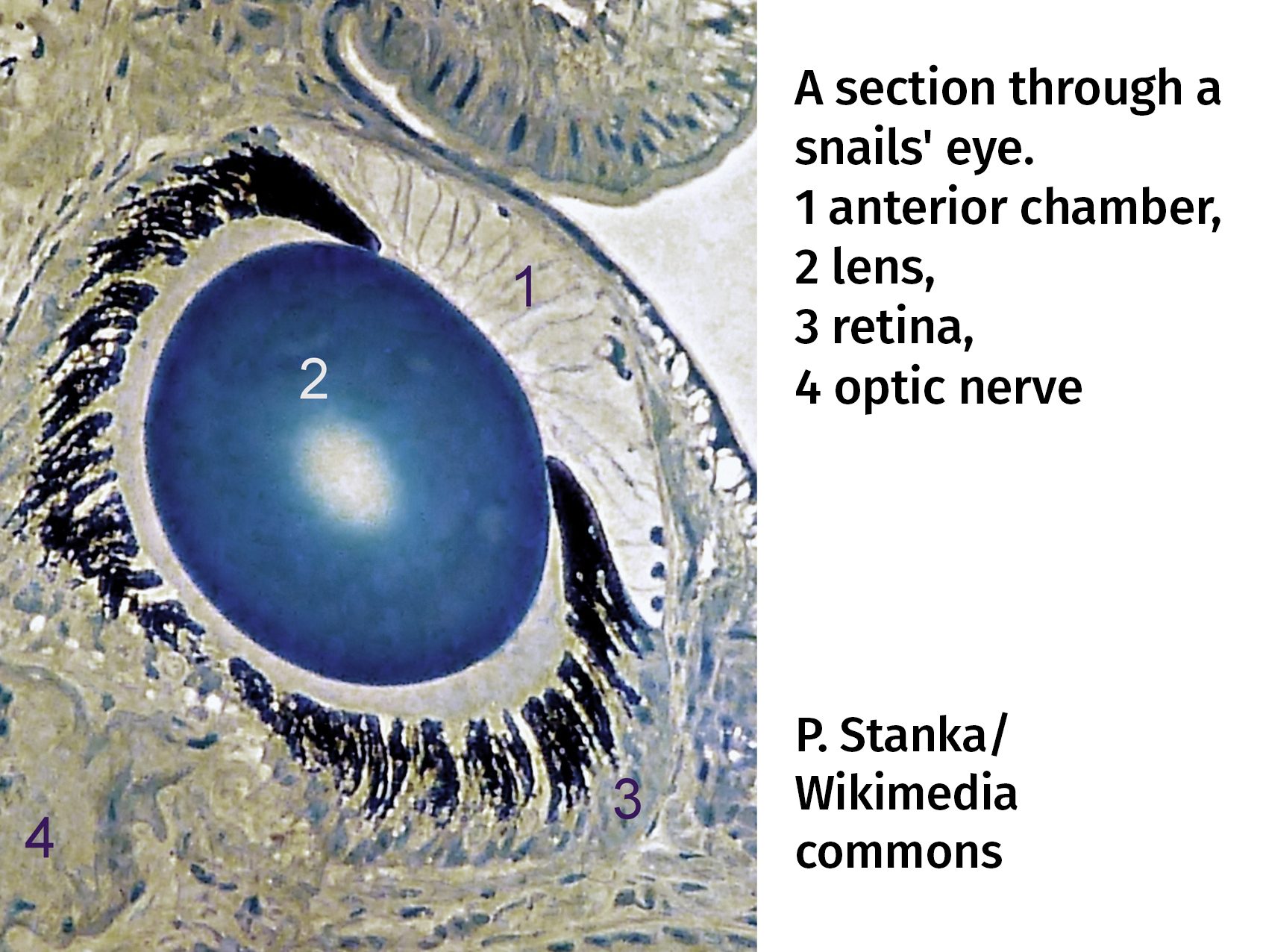
Shell
As the snail grows so does its shell, as new calcium carbonate is secreted by glands in the snail's mantle and added to the shell opening, Most snail shells are right-handed if you hold the shell with the centre pointing towards you, the spiral swirls in a clockwise direction to the opening.
Right- or Left-handed?
The shell swirl reflects the handedness of the snail's internal organs. Takahiro Asami says "[This] is a potential mechanism for producing new species in snails ... the genital apparatus is located in the opposite side of the body between right- and left-handed snails so that mating between the two is impossible."
'Jeremy' the left-handed snail hit the headlines in 2016 after an appeal to find a similarly left-handed mate. It didn't take long for two suitors to be found, one from Spain and one from Ipswich. Angus Davison shares the results of his studies into the genetics of body asymmetry that 'Jeremy' and partners initiated.
Foot
The snail moves about by gliding along on a large, muscular foot at a proverbially low speed, typically 1 mm/s. It secretes mucus from its skin, which lubricates the surface upon which it crawls. It can easily glide over many surfaces, including glass, it can even move over a sharp razor blade without getting cut, thanks to the protective mucus. They leave a slime trail behind them, visible as a shiny "path", that the snail can use as a guide path between safe feeding and sleeping areas.
SNAIL SLIME
Snail slime acts as both a lubricant and a glue, allowing them to crawl up vertical surfaces without falling off. While moving it is thin, allowing smooth movement, but once they stop it becomes sticky, which enables them to attach to a surface at any angle.
Image: Helix pomatia crawling over the razor blade. Michal Maňas, Wikimedia.
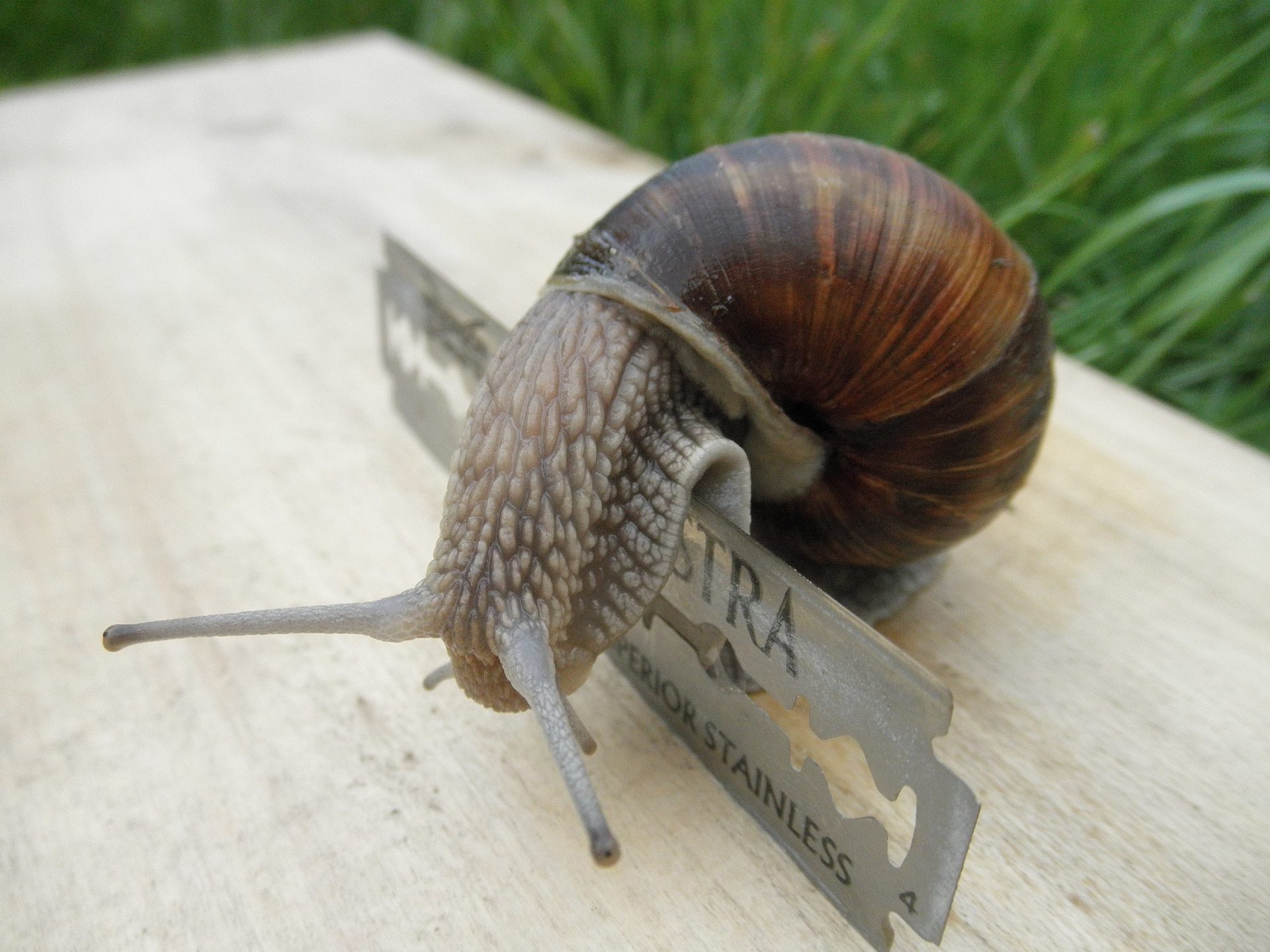
Eating
The radula is a ribbon-like structure inside the snail’s mouth with rows of minute chitin teeth. It scrapes and cuts the food before it passes through the oesophagus to continue the digestion process.
Diagram
A transverse view of the buccal cavity of a gastropod, showing the radula and how it is used. The snail body is shown in green and food is shown in blue. Muscles that control the radula are shown in brown. The surface of the radula ribbon, with numerous teeth, is shown as a zig-zag line.
e = oesophagus, m = mouth, mx = maxilla,
o = odontophore,
op = odontophore protractur muscle,
r = radula,
rp = radula protractor muscle,
rr = radula retractor muscle
© Debivort, wikimedia


Snail anatomy
© Lukaves, Dreamstime.com
Courtship in Helix pomatia
© Jangle1969, Wikipedia
The love dance of snails
Roman snails are simultaneous hermaphrodites; having both male and female sexual organs.
How is this an advantage?
Because of their slow speed, they can only search for a partner in a small area, and if they were male or female there would then be a 50:50 chance that any partners found would be the wrong sex, lowering their reproduction rate. However, being hermaphrodites doubles the chances of success, as they are simultaneously male and female.
On the surface both snails wanting to exchange sperm to fertilise their eggs should be straightforward, however, it turns out that it is a surprisingly complex procedure.
Once they find a partner Roman snails have an elaborate and tactile courtship ritual, raising their heads and putting their flat foot soles against each other. They touch each other with tentacles and lips, bite each other's lips and around the genital pore while they sway gently. This courtship process may last as long as twenty hours.
During the dance each snail manoeuvres to get its genital pore in the best position to fire its love-dart.
The successful snail fires their dart into the side of its mate, piercing its body wall. The pricked snail becomes visibly more excited and active. Sometimes it is fired so forcefully that it can end up buried in the internal organs or piercing the body or head entirely and protruding out of the other side.
Helix aspersa before mating, the snail on the right showing a love dart, circled in orange. © Eynar, Wikimedia
The love-dart is coated in a cocktail of chemicals. Once these enter its mate’s bloodstream they trigger a variety of physiological and behavioural responses that increase the chances of the dart shooter’s sperm fertilising its mate’s eggs.
A snail does not have a dart to fire the very first time it mates because the first mating is needed to trigger dart formation. Once a snail has mated, it fires a dart before some, but not all, subsequent matings. A snail often mates without having a dart to use, because it takes time to create a replacement dart.
The dart is shot with some variation in force, and with considerable inaccuracy, with some failing to penetrate the skin, or miss the target altogether. Snails have only very simple visual systems and cannot see well enough to use vision to help aim the darts.
After mating the sperm is stored in a special pouch. Fertilisation does not happen until the eggs are laid.
Read more:
Christopher Foote, BMC blog: A love-dart at the heart of sexual conflict in snails.
Robert Nordsieck, The Living World of Molluscs.
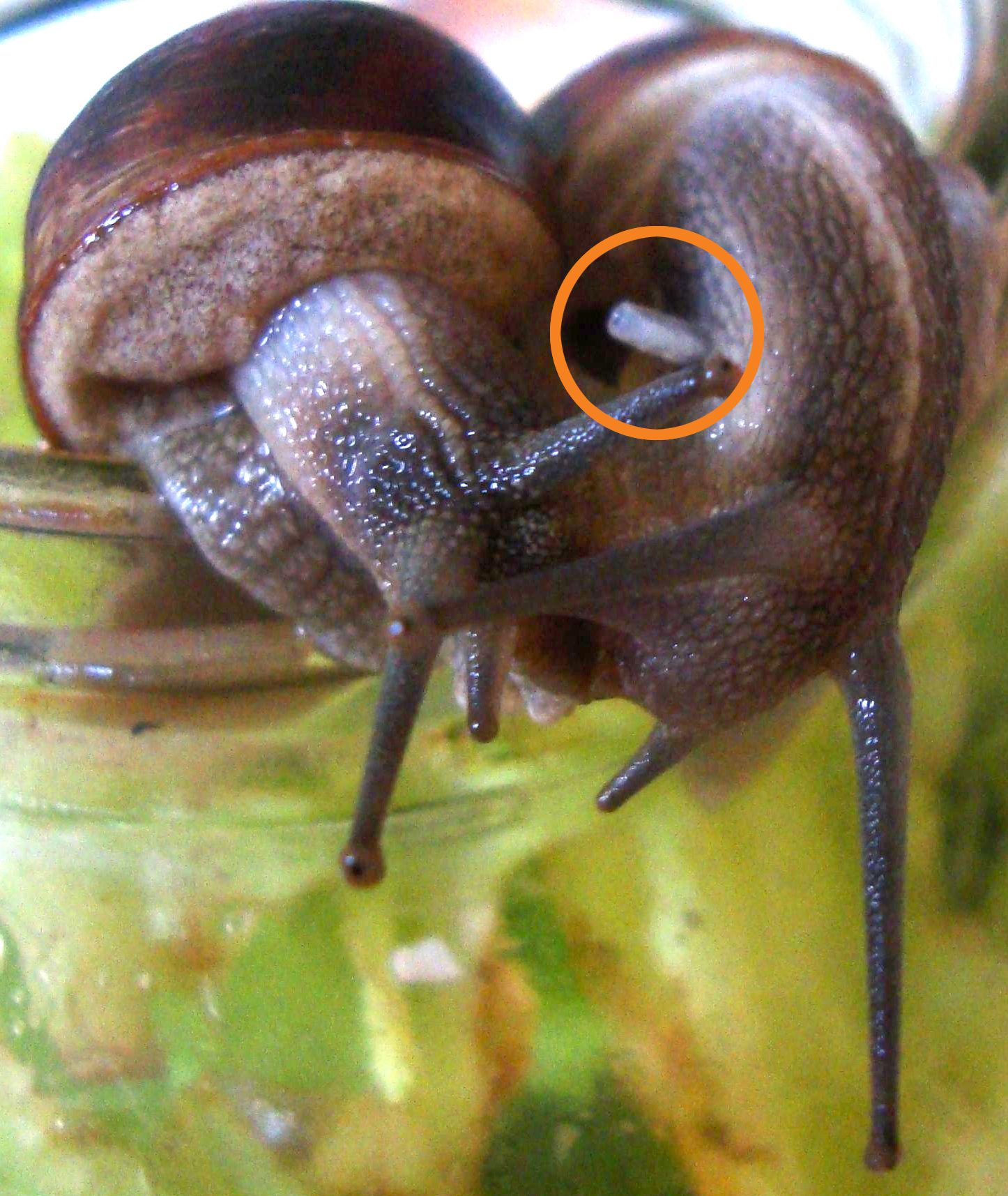
A closer look at love-darts
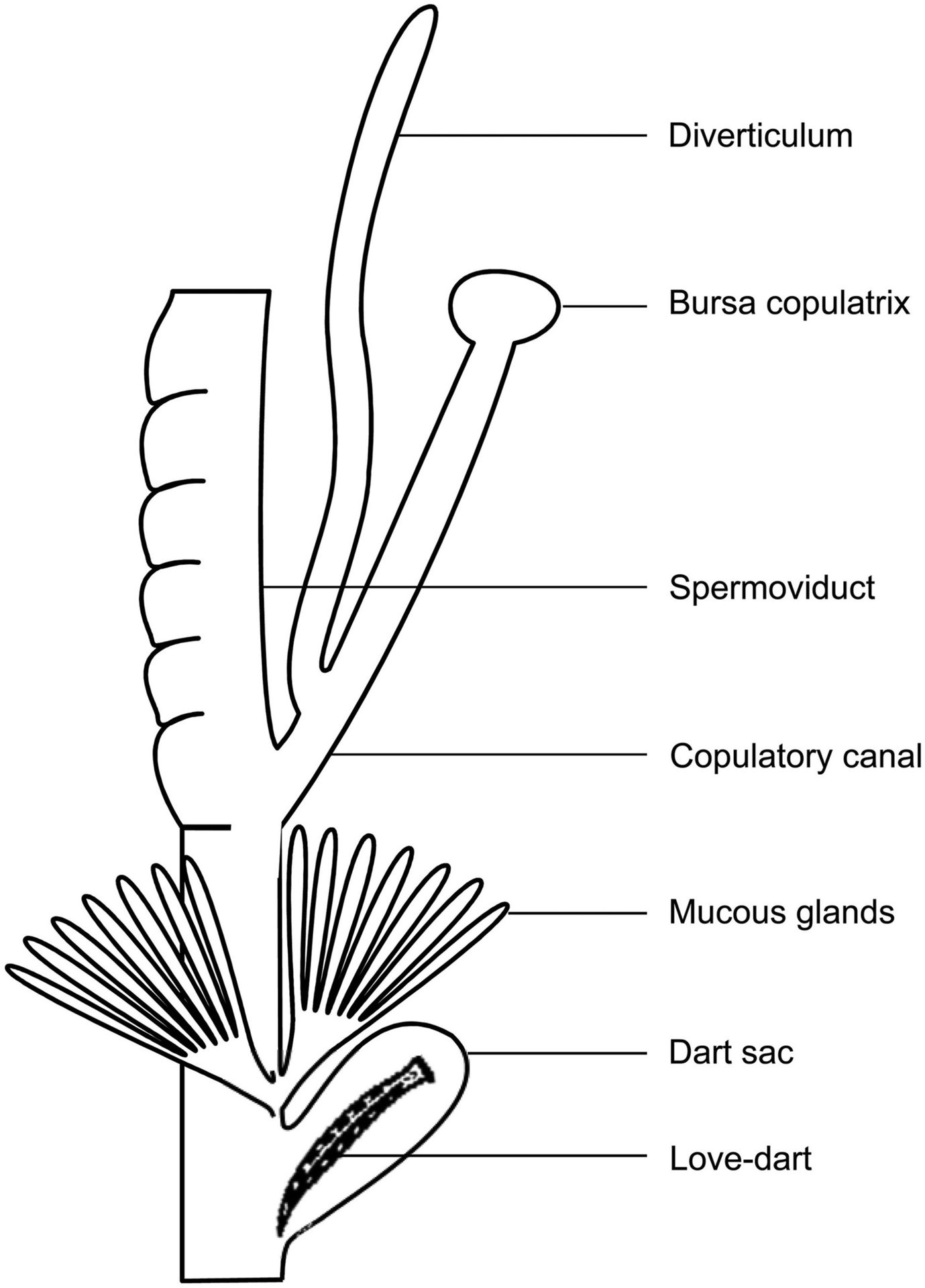
A portion of the reproductive system showing the dart sac that hosts the love-dart; the mucous glands that produce mucus coating the dart's surface; the copulatory canal leading to the bursa copulatrix; the bursa copulatrix, which is responsible for digesting the sperm and the remains of the spermatophore; the diverticulum that receives the spermatophore of the partner; and the spermoviduct, through which the sperm of the partner travel to reach the spermatheca (sperm storage organ).
© Monica Lodi and Joris M. Koene, The love-darts of land snails: integrating physiology, morphology and behaviour, Journal of Molluscan Studies, Volume 82, Issue 1, February 2016, Pages 1–10, https://doi.org/10.1093/mollus/eyv046
To understand the love-dart’s effects we need to delve deeper into the reproductive process.
Sperm enters via a long tunnel known as the diverticulum. Sperm has to pass through here to reach the copulatory canal, from where it can make it to the atrium and sperm storage organ and have a chance of fertilising the eggs. However, sperm in the copulatory canal can also be sucked into the bursa copulatrix and digested, leaving no chance of fertilisation.
As the snails can mate multiple times, with different ‘fathers’ fertilising their eggs, a conflict occurs. The sperm donor wants to maximise the number of eggs they fertilise. However, it is beneficial for eggs to be fertilised by multiple males. So the sperm recipient may not want all the sperm from one male to reach the eggs and will be happy for a quantity to be lost in the diverticulum or digested in the bursa copulatrix.
A successfully deployed love-dart tips the scales in favour of the sperm donor. The chemicals covering the dart increase the number of contractions in the diverticulum (assumed to make the uptake of sperm easier) and causes contractions in the copulatory canal, reducing access to the bursa copulatrix entrance and making sperm less likely to be digested. The successful use of a love-dart more than doubles the paternity of a mate’s eggs.
In a Japanese snail, Euhadra quaesita, the love-dart can cause behavioural changes in their partner, reducing their inclination to mate with other snails afterwards, thus increasing the number of eggs that will be fertilised by the dart-firing male. At present, it is not clear how widespread these effects are in other snails.
In the BMC blog post, A love-dart at the heart of sexual conflict in snails, Christopher Foote says that recent research:
supports the idea that the diverticulum has evolved as a defense against the manipulative effects of love-darts on sperm uptake in the copulatory canal. A longer diverticulum guards against this by increasing the number of contractions needed for sperm to make it to the copulatory canal. In turn, species with long diverticulums (like garden snails) have evolved an increasingly potent love-dart mucus as a counter-measure.
Snails appear to be locked in an on-going arms race; males improving the potency of their love darts, females improving their defences against this tactic. An arms race which is made all the stranger by each individual snail being both male and female, attacker and defender, at the same time. Those snails eating your plants are living more complex lives than we might have imagined…

Drawing of love dart of Helix pomatia. Cross-section (on the left) and lateral view (on the right)
Taken from Figure 3 from: Joris M. Koene and Hinrich Schulenburg: Shooting darts: co-evolution and counter-adaptation in hermaphroditic snails. - BMC Evolutionary Biology, 2005, 5:25 doi:10.1186/1471-2148-5-25.
In June and July, after a long courtship and successful mating, the snails will lay clutches of 40–65 eggs.
An African land snail shows the egg-laying process. © GeninD, TikTok
